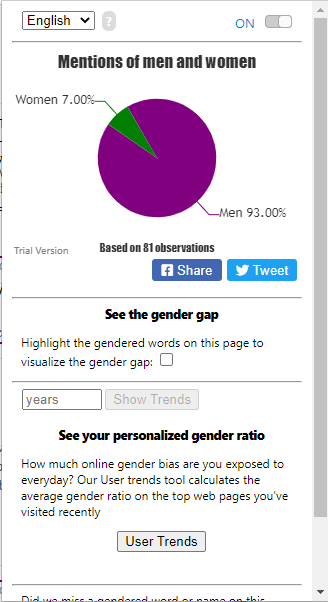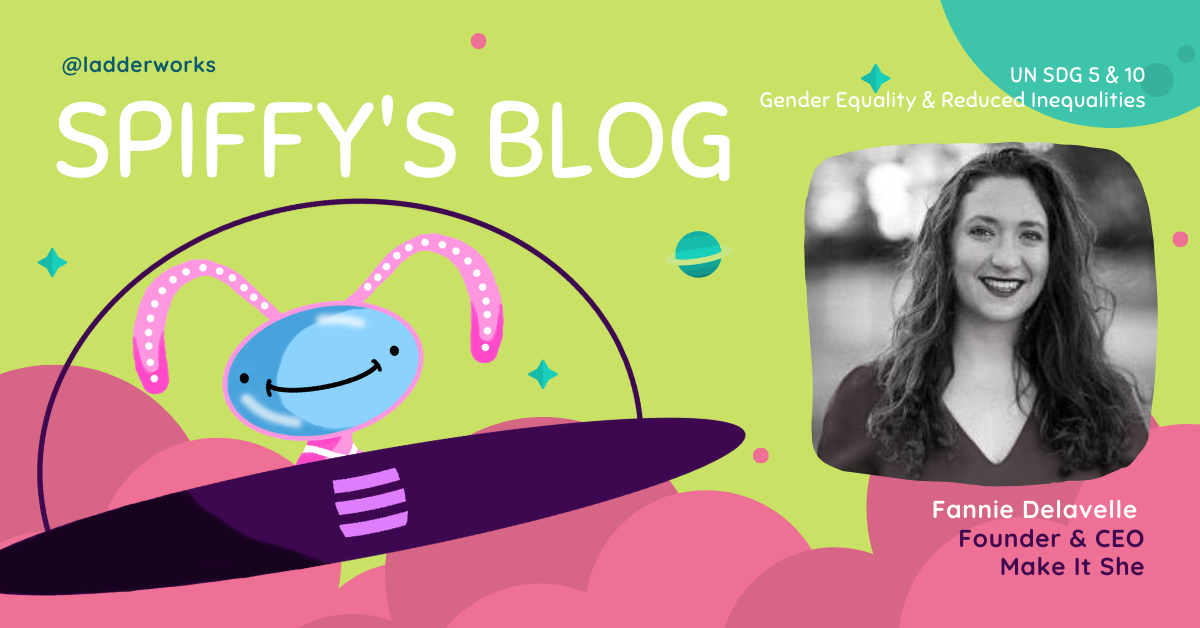Fannie Delavelle: Making Online Gender Bias a Thing of the Past

Hi everyone! I’m Spiffy, your favorite interplanetary journalist reporting from Planet Earth with an eye on entrepreneurs making a difference on gender equality. Today I’m going to learn about gender bias in digital news, and how Make it She is causing online gender bias to be a thing of the past. Join me as I welcome Fannie Delavelle, founder and CEO of Make it She.
Spiffy: Welcome, Fannie! I understand you’re making some waves! Tell me, what challenge are you addressing?
Fannie: Well, Spiffy, did you realize that our online world is gender-biased? For example, only 18% of biographies on Wikipedia are about women, despite thousands of women meeting Wikipedia’s notability standards. In digital news platforms, only one-in-three-mentions of a person is a woman, in part because the search algorithms used by journalists to find sources to interview overrepresent men. Over the long-term, this gender gap in online representation shapes our beliefs of what women can accomplish by amplifying society’s gender biases.
Spiffy: I am shocked! How is this possible in the 21st Century? What motivated you to address online gender bias?
Fannie: Seeing is believing! The more we read about women experts, politicians, and entrepreneurs online, the more we’ll believe that we can also make it. I use the app every day, and every day my motivation to bridge the online gender gap gets strengthened: reading an article on Ruth Bader Ginsburg? There are 65% male-mentions on the page. Looking at the main page of the New York Times? There are never more than 40% female-mentions. Successful women can serve as role models and boost other women’s confidence, but only if they are visible to the public.
Spiffy: I absolutely agree that seeing is believing! How are you working to alleviate this problem and create a more equitable world?
Fannie: Our goal is to make the web gender equal. To reach that goal, Make it She reveals the online gender gaps by providing users with the ratio of male-to-female-mentions on any webpage. The evolution of this ratio can be observed over several years on the main webpages visited by each user. We also work with journalists and bloggers to help them make their content more gender equal. Biases developed through years of web browsing are not permanent. Their impact on our behaviors can be mitigated.

Screenshot of one of Make it She's functionalities. (Photo courtesy of Fannie Delavelle)
Spiffy: Amazing! Can you tell me about a recent milestone that you’ve achieved?
Fannie: We recently developed a new algorithm that calculates the evolution of the average gender ratio on any website in the past 10 years. This is groundbreaking because it enables us to see whether a website has gotten more or less gender equal over time. It also helps put pressure on organizations that haven’t made any progress with online gender equality. You can also use this tool to choose which websites to visit — if a digital newspaper has a terrible gender record, you can decide to read it less often.
Spiffy: So we will be able to hold the reins of digital news sourcing? This is brilliant! Fannie, can you share an experience when you faced failure and didn't give up. What did you learn from failure?
Fannie: The first version of the app looked very different from today’s version. Instead of providing gender ratios, it replaced male-mentions with female ones on any webpage to make a point. It took a lot of work to build, but it got negative feedback from test users. Women didn’t trust an app that changes the text on webpages, and men were uneasy with being erased from the internet. It was a setback, but it helped me create a tool that encourages all users to bridge the gap rather than antagonize half of them.
Spiffy: Great pivot, Fannie! Last question for you, what is something you've unexpectedly learned from someone recently?
Fannie: A few weeks ago, a friend had to change countries, jobs, and as a result friends, because of factors outside of her control. She could have dwelt on self-pity, but she decided to turn this unwanted turn of events into an opportunity. She made a career move and landed a job in a field that she wanted to enter for years but hadn’t mastered the courage until now. Watching her, I learned that it’s your reaction to change that defines the impact it will have on your life.
Fannie Delavelle works at the World Bank Gender Innovation Lab and is the founder and CEO of Make it She. Prior to her start-up, Fannie helped develop the World Bank’s first blockchain solution to make international trade more inclusive and was the trade attache at the Embassy of France in the United States. (Nominated by the World Bank)


